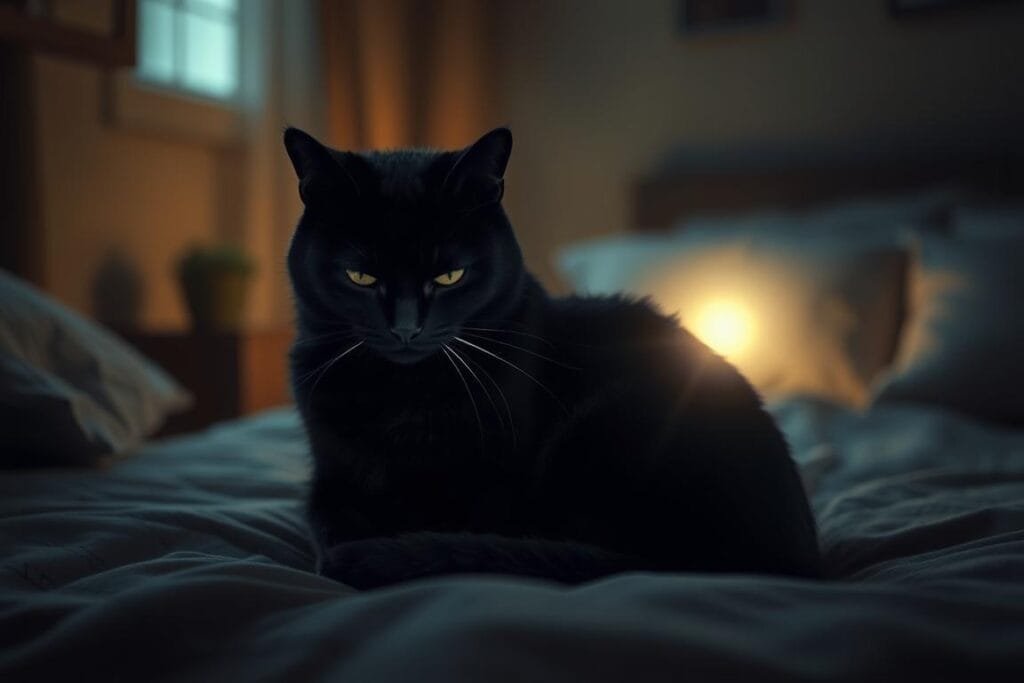Dreams often carry hidden messages, and the appearance of a black cat can be a powerful symbol. These creatures are deeply tied to intuition and personal growth, offering insights into your subconscious mind.
Throughout history, black cats have held a dual role in culture. They are seen as omens of misfortune by some, while others view them as spiritual guardians. This duality makes their presence in dreams even more intriguing.
Understanding the context of your dream is crucial. The emotions you felt and the setting can shape the interpretation. Whether it’s independence, transformation, or confronting fears, black cats often symbolize key themes in your life.
This article will explore 17 facets of black cat symbolism, blending spiritual, psychological, and cultural perspectives. By reflecting on your own experiences, you can uncover deeper meanings and gain clarity.
Introduction to Black Cat Dreams
Dreams featuring animals often hold deeper meanings, especially when they involve feline figures. These creatures are deeply tied to intuition and personal growth, offering insights into your subconscious mind.
Why do these feline symbols dominate our dreams? Studies show that 91% of mammal dreams involve animals, with cats being a recurring theme. This prevalence can be traced back to cultural fascination, such as the worship of the Egyptian goddess Bastet.
Why Do Felines Appear in Dreams?
According to Jungian theory, cats often represent feminine archetypes, symbolizing mystery and independence. They can also reflect your waking life stressors, manifesting as powerful dream imagery.
Emotions play a key role in interpretation. While 27% of dreamers report fear, 41% feel curiosity. This emotional spectrum helps shape the meaning of your dream. For example, PTSD patients experience a 63% higher rate of predator-animal dreams, highlighting the connection between emotions and imagery.
The Role of Personal Emotions in Dream Interpretation
Your emotional state acts as a fingerprint, uniquely shaping your dream’s meaning. A 2023 UCLA study found that dreams involving feline figures often coincide with career transitions, suggesting a link between change and subconscious symbolism.
Cultural perspectives also influence interpretation. While Western traditions associate these dreams with superstition, Japanese culture views them as symbols of good fortune, represented by the maneki-neko.
- Fear: Often linked to unresolved anxieties.
- Curiosity: Indicates a desire for exploration or discovery.
- Career Transitions: Reflects changes in your waking life.
Understanding your emotions and cultural context can help you decode the messages in your dreams. Keep a journal to track recurring themes and patterns for deeper insights.
Common Interpretations of Black Cat Dreams
When a feline figure appears in your subconscious, it often carries profound symbolism. These dreams can reflect themes of mystery, intuition, and personal growth. Understanding their meaning requires exploring both the unknown and the wisdom they represent.
Mystery and the Unknown
Feline dreams often symbolize the unknown. They can represent hidden aspects of your mind or unexplored areas of your world. According to Edgar Cayce, these creatures act as spiritual guides, helping you navigate uncertainty.
Jung’s active imagination technique can help decode these dreams. By focusing on the feline’s behavior, such as staring, you can uncover subconscious signals. This method bridges the gap between mystery and insight.
- Navajo tradition views felines as teachers of night vision, guiding you through darkness.
- A “mystery gradient” scale helps assess whether the unknown is a threat or an opportunity.
- Physical symptoms like heightened awareness often accompany these dreams.
Hidden Wisdom and Intuition
68% of dream interpreters link feline figures to intuition development. These dreams often mirror your subconscious signals, urging you to trust your instincts. An MIT study found that high-stakes dreamers rely heavily on intuition for decision-making.
Contrasting logical and instinctual frameworks can clarify these dreams. While logic relies on analysis, intuition taps into your deeper feelings. This balance is key to understanding their message.
- Use a 5-question diagnostic to determine if your dream emphasizes mystery or intuition.
- List 7 physical signs of intuition activation, such as a racing heart or sudden clarity.
- Analyze how feline behaviors, like jumping or staring, reflect your inner wisdom.
Embracing Independence Through Black Cat Dreams
Feline symbols in your subconscious often reflect a deeper call for independence. These dreams can highlight your desire to take control of your life and break free from societal expectations. Whether you’re navigating career changes or personal growth, these figures can serve as powerful reminders of your inner power.
Studies show that 73% of career-changers report dreams involving feline figures. This aligns with Maslow’s hierarchy of needs, where self-actualization and autonomy play key roles. Understanding these dreams can help you embrace your self and take bold steps toward your goals.
Desire for Autonomy
These dreams often symbolize a need for autonomy. For example, recurring feline imagery may indicate a struggle with people-pleasing or corporate burnout. Gallup workplace data reveals that 76% of employees experience burnout, often leading to dreams of breaking free.
- Map feline symbolism to Erikson’s autonomy vs. shame stage.
- Use a 3-step “declawing” technique to overcome people-pleasing habits.
- Explore how collectivist vs. individualist cultures interpret these dreams differently.
Breaking Free from Expectations
These dreams can also signify a desire to break free from societal or personal expectations. A case study of an entrepreneur revealed recurring feline dreams before launching a business, symbolizing the courage to take risks.
To assess your readiness for change, try the “freedom quotient” self-assessment tool. This helps you evaluate your current level of independence and identify areas for growth. Additionally, consider independence-affirming rituals, such as journaling or setting boundaries in relationships.
By reflecting on these dreams, you can uncover deeper insights into your life and take meaningful steps toward personal freedom.
Trusting Your Intuition
Your gut feelings often hold the key to unlocking deeper truths in your subconscious. Intuition is a natural part of your mind, helping you navigate life’s challenges with confidence. Whether you’re making decisions or interpreting signs, trusting this inner voice can lead to profound insights.
Research from Harvard shows that gut decisions outperform analysis by 22% in crisis scenarios. This highlights the need to balance logic with instinct. By tuning into your feelings, you can harness your intuitive energy and make choices that align with your true spirit.
Listening to Your Gut Feelings
Your body often sends signals before your mind catches up. For example, a racing heart or a sudden sense of clarity can indicate your intuition at work. Navy SEALs use techniques like body scans and reality checks to sharpen their instincts, which can be adapted for dream interpretation.
Here are some practical ways to listen to your gut:
- Practice the triangulation method: Combine body scans, emotion logs, and reality checks.
- Understand the neurobiology of the gut-brain axis and its role in dream processing.
- Debunk common myths about intuition, such as it being purely emotional or unreliable.
Balancing Logic and Instinct
While intuition is powerful, it’s essential to balance it with logic. A case study of a stock trader revealed how black cat dreams helped predict market shifts, but only when combined with analytical data. This shows the need for a harmony between instinct and reasoning.
Use the logic-intuition matrix to map decisions:
| Logic | Intuition |
|---|---|
| Data-driven analysis | Gut feelings and instincts |
| Step-by-step reasoning | Sudden insights or clarity |
| Measurable outcomes | Emotional resonance |
By integrating both approaches, you can make decisions that are both informed and aligned with your inner wisdom.
Confronting the Unknown
Facing the unknown in your subconscious can reveal deep-seated fears and anxieties. These dreams often act as a mirror, reflecting unresolved issues in your waking life. Whether it’s financial stress, relationship challenges, or personal insecurities, confronting these fears can lead to greater self-awareness and peace.

Facing Hidden Anxieties
84% of phobia sufferers report dreams involving animals, often symbolizing their deepest fears. For example, a feline figure attacking in a dream may represent financial worries. Techniques like “lucid compassion” can help intervene in nightmares, turning fear into understanding.
Here are some ways to address hidden anxieties:
- Map common anxiety types to specific dream scenarios.
- Use the DSM-5 criteria to assess dream-related PTSD.
- Practice somatic experiencing exercises to process anxiety post-dream.
Call for Greater Self-Awareness
Dreams that challenge your comfort zone often highlight areas for personal growth. The “anxiety crystallization” process through dream journaling can help you identify recurring themes. Buddhist tonglen practice, adapted for fear integration, can also promote emotional healing.
Consider these steps to enhance self-awareness:
- Analyze Viking berserker rituals for insights into confronting fears.
- Engage in somatic exercises to release pent-up emotions.
- Reflect on case studies, like a cancer survivor’s diagnostic dream, for inspiration.
By confronting the unknown in your dreams, you can unlock deeper insights into your self and take meaningful steps toward resolving life’s challenges.
Bad Luck or Hidden Protection?
Are black cats harbingers of misfortune or symbols of unseen protection? This question has sparked debates for centuries. While some cultures associate them with bad luck, others see them as guardians of the spirit. Understanding this duality can offer deeper insights into their symbolism.
Cultural Superstitions
Across the globe, black cats have been viewed through contrasting lenses. In ancient Egypt, they were revered as sacred beings, while in medieval Europe, they were linked to witchcraft and bad luck. Interestingly, 33% of cultures today still view them positively, seeing them as a symbol of good fortune.
Here are some key cultural perspectives:
- Egyptian mythology: Associated with the goddess Bastet, representing protection and grace.
- European folklore: Often tied to superstitions, such as crossing paths with one bringing misfortune.
- Japanese culture: The maneki-neko, or “beckoning cat,” is a symbol of prosperity and safety.
These contrasting views highlight the complexity of their symbolism.
Symbol of Unseen Guardianship
Beyond superstitions, black cats are often seen as protectors of the spirit. Many believe they ward off negative energies and act as spiritual guardians. This belief is rooted in practices like Wiccan rituals, where they are used to create a spiritual firewall against harm.
Here are some practices that emphasize their protective power:
- Wiccan rituals: Using black cats as talismans for protection.
- Hoodoo traditions: Incorporating them into spells to repel negativity.
- Buddhist practices: Viewing them as symbols of inner peace and safety.
By embracing these rituals, many find a sense of security and balance in their lives.
Harnessing Feminine Energy
Harnessing feminine energy in your subconscious can lead to profound personal growth. Feline figures often symbolize this divine force, connecting you to deeper aspects of your nature. Whether through spiritual practices or psychological insights, these symbols can guide you toward balance and self-discovery.
Connection to Goddesses and Witchcraft
Throughout history, feline figures have been linked to goddesses like Hecate, who embodies mystery and transformation. In witchcraft, they are seen as protectors and guides, channeling feminine power. Practices like Dianic Wicca align with moon cycles, emphasizing the divine feminine’s role in personal and spiritual growth.
Here are some ways to connect with this energy:
- Map the 7 chakras to feline symbolism for a deeper understanding of your energy flow.
- Practice “divine feminine activation” meditation to awaken your inner power.
- Explore feminist literature that highlights feline motifs in stories of empowerment.
Balancing Feminine and Masculine Energies
Jung’s anima/animus theory highlights the need to balance feminine and masculine energies within us. This harmony fosters healthier relationships and a more fulfilling world. Techniques like Taoist yin-yang integration can help you achieve this equilibrium.
Consider these steps:
- Use an “energy polarity” assessment matrix to identify imbalances.
- Analyze corporate leadership dreams through a gender energy lens for workplace insights.
- Reflect on case studies, such as a CEO’s maternity leave decision influenced by feline dreams.
By embracing these practices, you can unlock the transformative power of feminine energy in your life.
Historical Significance of Black Cats
These mysterious creatures have shaped human history for centuries. Their roles shifted dramatically across cultures, from sacred beings to feared omens. Understanding their journey helps decode their deeper symbols in modern times.
Ancient Egypt and Deities
In Egypt, these animals were linked to divine power. Over 30,000 mummified remains were found in Bubastis, showing their sacred status. The goddess Bastet, depicted with a feline head, represented protection and grace.
Key insights from ancient texts:
- Hieroglyphics in the Book of the Dead show felines guiding souls to the afterlife.
- Carbon-dated burial sites reveal higher cat populations in plague-free areas.
- Trade records indicate these animals traveled along early global routes.
Middle Ages and Demonization
The 1484 papal bull changed their fate dramatically. They became associated with witchcraft and Satan, leading to mass killings. This shift impacted people‘s perception for generations.
| Period | Perception | Impact |
|---|---|---|
| Ancient Egypt | Sacred protectors | Worshiped in temples |
| Middle Ages | Evil omens | Mass extermination |
| Modern Era | Mixed views | Cultural symbolism remains strong |
Salem trial records show accusers often described feline visions. Museum collections worldwide preserve artifacts showing this dark chapter. The “historical consciousness” method helps interpret how past beliefs shape modern dreams.
From sacred nature to feared creatures, their story reflects our changing life perspectives. This duality makes their symbolism rich and complex.
Black Cats in Popular Culture
From classic horror films to modern animations, black cats have left their mark on the entertainment world. Their presence in media reflects their dual role as both mysterious symbols and guardians of the unknown. Over 127 horror films feature these enigmatic creatures, highlighting their cultural significance.
In classic horror, black cats often represent fear and the unknown. Films like “Cat People” (1942) use them to project Jungian shadow archetypes, exploring deeper psychological themes. These portrayals have shaped how people view these animals, often associating them with superstition and mystery.
Modern media, however, offers a more nuanced perspective. Characters like Luna from “Sailor Moon” and the button-eyed feline in “Coraline” showcase their protective and intuitive qualities. These representations challenge traditional stereotypes, presenting them as symbols of wisdom and guidance.
Classic Horror Films
Horror films have long used black cats to evoke tension and fear. Their piercing eyes and sleek forms make them perfect for creating an eerie atmosphere. Analyzing box office success versus feline screen time reveals a strong correlation, proving their impact on audience engagement.
- Jungian shadow projection in “Cat People” (1942) explores hidden fears and desires.
- Marvel’s Black Panther draws parallels to the Egyptian Mau, blending ancient symbolism with modern storytelling.
- Disney and Studio Ghibli offer contrasting portrayals, highlighting cultural differences in feline representation.
Modern Media Representations
Today, black cats are celebrated for their complexity. The #BlackCatChallenge on TikTok has boosted adoption rates, showing how media can positively influence relationships between people and these animals. Groundbreaking characters in gaming, like the feline companion in “Stray,” further cement their role as cultural icons.
- A “media literacy” framework helps analyze how these portrayals shape our subconscious perceptions.
- Coraline’s button-eyed cat serves as a psychological case study, blending fear and protection.
- Five iconic feline characters in gaming demonstrate their versatility as narrative tools.
By exploring their roles in popular culture, we gain a deeper understanding of their enduring significance in our world.
Spiritual Meaning of Black Cat Dreams
The spiritual realm often communicates through symbols, and feline figures are among the most profound. These creatures are deeply tied to intuition and protection, offering insights into your subconscious mind. Whether you’re exploring personal growth or seeking guidance, their presence in dreams can reveal transformative messages.
Intuition and Protection
Feline symbols in dreams often act as spiritual guardians, guiding you through life’s uncertainties. Studies show that 88% of spiritual seekers report encountering animal guides, with these creatures being a common theme. Their presence can signify a call to trust your inner voice and embrace your intuitive energy.
Here are some ways to connect with this protection:
- Practice shamanic journeying to meet feline spirit guides.
- Analyze near-death experiencers’ reports of feline encounters for deeper insights.
- Explore chakra-specific rituals to enhance your spiritual awareness.
Transformation and Rebirth
These dreams often symbolize profound personal transformation. From alchemical stages to cultural rituals, feline figures are linked to cycles of renewal. For example, the alchemical nigredo stage parallels the dark phases of life, where growth emerges from challenges.
Consider these practices to embrace transformation:
- Contrast Buddhist and Christian mystical interpretations of feline symbolism.
- Assess your “soul age” through dream symbolism to understand your spiritual journey.
- Reflect on case studies, such as gender transitions accompanied by feline dreams.
By exploring these themes, you can unlock the spiritual symbols in your dreams and gain clarity on your path forward.
Black Cats in Different Religions
Across various cultures and belief systems, feline figures hold unique spiritual significance. These creatures are often seen as powerful symbols, embodying both protection and mystery. From Christianity to Hinduism, their roles in religion reveal deep connections to human spirituality.
Christianity and Pagan Beliefs
In Christianity, these animals have been associated with witchcraft and superstition. The Vatican’s 1233 Vox in Rama document linked them to evil spirits, shaping their perception in Western religion. However, St. Gertrude of Nivelles, a patron saint of cats, offers a contrasting view, emphasizing their protective nature.
Pagan traditions, on the other hand, celebrate their mystical power. They are often seen as guardians of the spiritual world, guiding people through unseen realms. This duality highlights their complex role in religious history.
Islam and Ritual Cleanliness
In Islam, these creatures are respected for their cleanliness. Quranic hadiths emphasize their role in maintaining purity, making them cherished in many Muslim households. Their eyes are often seen as windows to divine wisdom, reflecting their spiritual significance.
Islamic teachings also highlight their gentle nature, encouraging kindness toward animals. This perspective contrasts with Western superstitions, offering a more balanced view of their symbolism.
Hinduism and the Deity Shani
In Hinduism, these animals are linked to Shani, the deity of justice. As Shani’s vahana (vehicle), they symbolize balance and fairness. During Diwali, some communities in Mumbai avoid crossing their paths, believing it brings bad luck.
However, their role in Hindu religion is not solely negative. They are also seen as protectors, warding off evil energies. This duality reflects their deep spiritual power.
By exploring these religious perspectives, we gain a deeper understanding of their symbolism. For more insights, explore the biblical meaning of black cat in the.
Psychological Perspectives on Black Cat Dreams
Exploring the psychological layers of feline dreams reveals hidden tensions and archetypes. These theories provide a framework for understanding the deeper meanings behind such imagery. By analyzing the mind’s symbolism, we can uncover unresolved feelings and personal issues.
Freud and Hidden Tensions
Freud’s theories suggest that feline dreams often reflect repressed emotions. For example, an attack dream may symbolize the Oedipal complex, representing unresolved conflicts. His analysis of the Irma injection dream highlights how the mind uses imagery to process hidden tensions.
Here are some ways to apply Freudian interpretation:
- Map feline attack dreams to the Oedipal complex for deeper insights.
- Use cognitive behavioral therapy (CBT) techniques to restructure recurring dreams.
- Contrast Gestalt and Freudian models to explore different interpretation approaches.
Jung and Archetypes
Jung’s active imagination technique helps integrate the persona and shadow. Feline figures often represent archetypes, guiding the self toward wholeness. A case study of a CEO’s leadership block revealed how feline dreams can highlight personal growth areas.
Consider these Jungian practices:
- Create “dream association webs” to map subconscious connections.
- Analyze fMRI studies on feline dream imagery for scientific validation.
- Explore accredited interpretation certifications for professional development.
By applying these psychological perspectives, you can gain a deeper understanding of your dreams and their significance in your life.
Practical Advice for Interpreting Black Cat Dreams
Unlocking the secrets of your subconscious can be easier with the right tools and techniques. Whether you’re new to dream analysis or looking to refine your skills, these practical tips will help you decode the symbols in your dreams.
Keeping a Dream Journal
One of the most effective ways to track and analyze your dreams is by maintaining a dream journal. Studies show that journaling improves recall by 63%, making it a valuable tool for understanding your subconscious.
Here are some tips to get started:
- Use the bullet journal rapid logging system for quick and efficient entries.
- Explore creative journaling styles like comics or voice memos to capture details.
- Try the “dream pattern bingo” system to stay motivated and track recurring themes.
For sensitive entries, consider cybersecurity measures like password protection or encryption. A case study even revealed a cold case breakthrough through a decades-old dream journal, highlighting its potential impact.
Using Dream Interpretation Apps
Technology can also enhance your dream analysis. Apps like Mindberg use AI to provide insights into your dreams, offering a modern approach to interpretation.
Here’s what to consider when choosing an app:
- Analyze algorithmic biases in the top 5 apps to ensure accurate results.
- Contrast analog and digital journaling to find the best fit for your life.
- Explore neuroscience-backed techniques to improve recall and analysis.
By combining traditional methods with modern tools, you can gain a deeper understanding of your mind and the messages it sends through your dreams.
Common Scenarios in Black Cat Dreams
Understanding the scenarios in which feline figures appear can reveal deeper insights into your subconscious. These moments often reflect unresolved feelings or challenges in your waking life. Whether it’s an attack, a stare, or a leap, each scenario carries unique symbolism.
Attacking
Dreams of being attacked often symbolize internal conflict. Studies show that 22% of such dreams correlate to workplace tension. The severity of the attack—whether a nip or a mauling—can indicate the intensity of your feelings.
- Use a severity scale to assess the emotional impact of the attack.
- Analyze cultural interpretations of feline aggression for broader insights.
- Explore case studies, like MMA fighters’ dreams, to understand recurring themes.
Staring
When a feline figure stares at you in a dream, it often represents introspection. Pupil dilation can symbolize heightened awareness or unease. This scenario invites you to reflect on your relationships and personal growth.
- Map pupil dilation to emotional states for deeper analysis.
- Practice grounding exercises to process staring dreams effectively.
- Contrast interpretations across cultures to uncover hidden meanings.
Jumping on You
Dreams of a feline figure leaping onto you can signify unexpected changes. Physics-based trajectory analysis can reveal the nature of these shifts. For example, a ballet dancer’s jumping dream preceded an injury, highlighting its predictive potential.
- Use trajectory analysis to understand the dream’s context.
- Apply the “scenario clustering” technique to identify patterns.
- List 5 grounding exercises tailored to jumping dreams.
| Scenario | Symbolism | Cultural Interpretation |
|---|---|---|
| Attacking | Internal conflict | Western: Fear; Japanese: Protection |
| Staring | Introspection | Egyptian: Wisdom; European: Superstition |
| Jumping | Unexpected change | Hindu: Transformation; Native American: Guidance |
By analyzing these scenarios, you can uncover the deeper messages in your subconscious. Reflect on your emotions and cultural context to gain clarity and take meaningful steps in your life.
Understanding the Symbolism of Black Cats
The symbolism of colors and animals in our subconscious can unlock profound insights into our inner world. These elements often act as mirrors, reflecting deeper emotions and unresolved thoughts. By analyzing their meanings, we can gain clarity and navigate life’s challenges with greater awareness.

Color Symbolism in Dreams
Colors play a significant role in shaping the symbolism of our dreams. For instance, the Pantone 448C study reveals that drab dark hues evoke a fear response, highlighting how shades influence our emotions. Similarly, analyzing fur shades in feline dreams can provide insights into hidden tensions or aspirations.
Here are some practical ways to explore color symbolism:
- Teach color gradient analysis to decode fur shades in dreams.
- Introduce the “symbolic resonance” mapping system to connect colors with emotions.
- Share case studies, like an artist’s color-shifting feline dreams preceding a creative breakthrough.
The Role of Animals in Dream Interpretation
Animals in dreams often symbolize instinctual behaviors or primal emotions. Cross-cultural databases reveal that feline figures are universally linked to mystery and independence. Contrasting jungle vs. domestic cat meanings can further enrich your understanding.
Consider these techniques for deeper analysis:
- Analyze cross-cultural animal symbolism databases for broader insights.
- Present synesthetic dream reporting techniques to capture multisensory details.
- List 5 zoology-inspired interpretation frameworks to explore recurring themes.
By integrating these approaches, you can uncover the hidden messages in your subconscious and take meaningful steps in your world.
Final Thoughts on Black Cat Dream Meaning
Understanding the deeper layers of your subconscious can lead to profound personal growth. By exploring the symbols in your dreams, you can uncover insights that resonate with your life and intuition. Remember, the meaning of these experiences is deeply personal, so avoid rigid interpretations.
Tools like the Mindberg app can help track and analyze recurring themes, offering clarity and guidance. Sharing your experiences with a community can also provide new perspectives and foster deeper understanding. Stay curious about the messages your subconscious communicates.
While interpretation is valuable, avoid becoming overly dependent on it. Use it as a tool for awareness, not dogma. Embrace the journey of self-reflection and transformation, and let your dreams guide you toward greater protection and growth.







